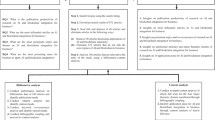Abstract
How to identify the same commodity entity from the multi-source heterogeneous, autonomous, independent, diverse, and inconsistent electronic commerce data is the main challenge for the present. By analyzing the data characteristics of different platforms, an index model based on commodity attribute/value is established firstly, and then we construct the global pattern of attribute value of commodity. It comes into being a unified model, quality and efficiency of commodity information data. Then based on the hierarchical probability model, the similarity of the identity of the goods is measured. We finished commodity entity recognition. And the normalized output is to meet the same set of commodities and sort. We construct experiments based on the Hadoop platform for the 3 B2C e-commerce data sources. And the traditional methods and products are compared. The experimental results demonstrate the feasibility, accuracy and efficiency of the framework.




Similar content being viewed by others
Change history
05 December 2022
This article has been retracted. Please see the Retraction Notice for more detail: https://doi.org/10.1007/s10586-022-03831-9
References
Fang, Q., Hu, Y., Lv, S., Guo, L., Xiao, L. Hu, Y.: IIRS: A Novel Framework of Identifying Commodity Entities on E-commerce Big Data. Web-Age Information Management. Lecture Notes in Computer Science, vol. 9098, pp. 473–480 (2015)
Altwaijry, H., Mehrotra, S., Kalashnikov, D.V.: QuERy: a framework for integrating entity resolution with query processing. Proc. VLDB Endow. 9(3), 120–131 (2015)
Li, L., Wang, H., Gao, H., Li, J.: EIF: A Framework of Effective Entity Identification. Web-Age Information Management. Lecture Notes in Computer Science, vol. 6184, pp. 717–728 (2015)
Fan, W., Gao, H., Jia, X., Li, J., Ma, S.: Dynamic constraints for record matching. VLDB J. 20(4), 495–520 (2011)
Deng, D., Li, G., Feng, J., Duan, Y., Gong, Z.: A unified framework for approximate dictionary-based entity extraction. VLDB J. 24(1), 143–167 (2015)
Nuray-Turan, R., Kalashnikov, D.V., Mehrotra, S., Yu, Y.: Attribute and object selection queries on objects with probabilistic attributes. ACM Trans. Database Syst. 37(1), 3 (2012)
Douglas, B., Ronald. F., Kolaitis P.G., Popa L., Wang-Chiew, T.: A declarative framework for linking entities. In: Proceedings of the the 18th International Conference on Database Theory (ICDT 2015), pp. 25–43 (2015)
Ribeiro, L.A., Härder, T., Pimenta, F.S.: A cluster-based approach to XML similarity joins. In: Proceedings of the 2009 International Database Engineering & Applications Symposium, ACM, New York, NY, USA, pp. 182–193 (2009)
Liao, Z., Zhang, Z., Liu, Y.: Chinese named entity recognition based on hierarchical hybrid model. Pricai Trends Artif. Intell. 6230, 620–624 (2010)
Chen, L., Jiang., Z.: Aircraft detection based on probability model of structural elements. SPIE/COS Photonics Asia International Society for Optics and Photonics, pp. 215–228 (2014)
Yang, Y., et al.: Link prediction in brain networks based on a hierarchical random graph model. Tsinghua Sci. Technol. 20(3), 306–315 (2015)
Liang, X.H., et al.: Improved coherent hierarchical culling algorithm based on probability computing model. J. Softw. 20(6), 1685–1693 (2009)
Gaetano, R., et al.: Unsupervised hierarchical image segmentation based on the TS-MRF model and fast Mean-Shift clustering. in: European Signal Processing Conference, IEEE, pp. 1–5 (2008)
Nogueira, A., et al.: Modeling self-similar traffic over multiple time scales based on hierarchical Markovian and L-System models. Comput. Commun. 33(17), S3–S10 (2010)
Yan, S.R., et al.: A graph-based comprehensive reputation model: exploiting the social context of opinions to enhance trust in social commerce. Inf. Sci. 318, 51–72 (2015)
Winn, J.K.: Electronic Chattel Paper Under Revised Article 9: Updating the Concept of Embodied Rights for Electronic Commerce. Social Science Electronic Publishing, 3 (2010)
Friedman, E.J., Halpern, J.Y., Kash, I.: Efficiency and nash equilibria in a scrip system for P2P networks. In: ACM Conference on Electronic Commerce, pp. 140–149 (2006)
Papyrakis, E., Gerlagh, R.: Resource-abundance and economic growth in the U.S. Soc. Sci. Electron. Publ. 51(4), 1011–1039 (2004)
Wang, Y.P.: Commodity information standardization can boost the healthy development of electronic commerce. Information Recording Materials (2016)
Najafi, I.: Identify effective factors for improving E-trust of E-transactions in the context of E-commerce and E-government. Int. J. Comput. Trends Technol. 17(6), 281–299 (2014)
Acknowledgements
This work was supported in part by the Supported by the construct program of the key discipline in QINGHAI province.
Author information
Authors and Affiliations
Corresponding author
Additional information
This article has been retracted. Please see the retraction notice for more detail:https://doi.org/10.1007/s10586-022-03831-9
Rights and permissions
Springer Nature or its licensor (e.g. a society or other partner) holds exclusive rights to this article under a publishing agreement with the author(s) or other rightsholder(s); author self-archiving of the accepted manuscript version of this article is solely governed by the terms of such publishing agreement and applicable law.
About this article
Cite this article
Zhang, Sf. RETRACTED ARTICLE: Electronic commerce commodity entity identities based on hierarchical probability model. Cluster Comput 22 (Suppl 4), 7787–7794 (2019). https://doi.org/10.1007/s10586-017-1437-8
Received:
Revised:
Accepted:
Published:
Issue Date:
DOI: https://doi.org/10.1007/s10586-017-1437-8




